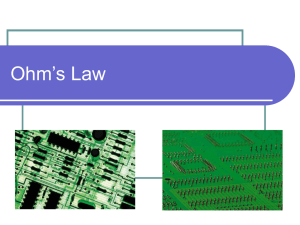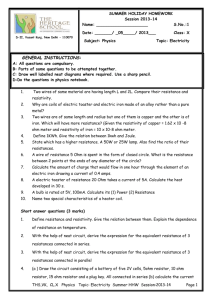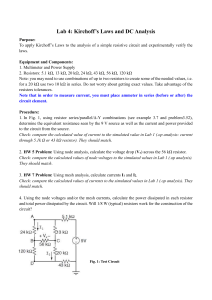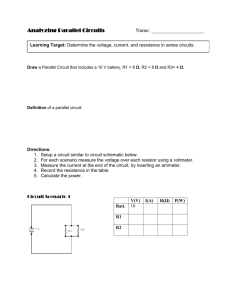Unit 2 - Lesson 5 - Series and Parallel
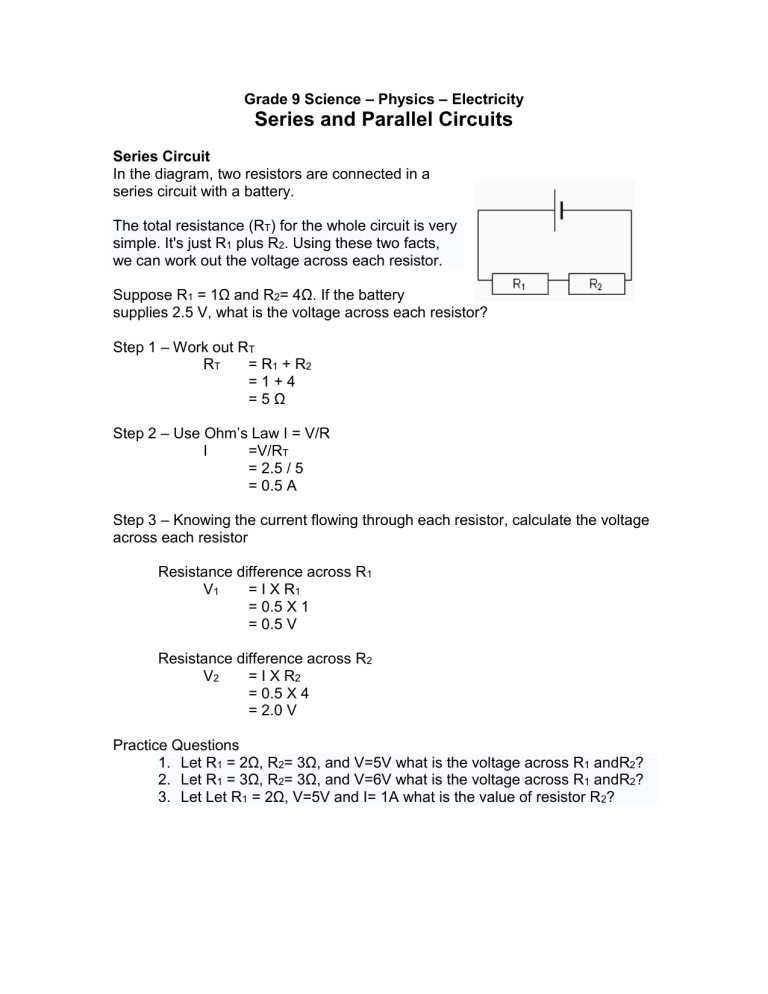
Grade 9 Science
– Physics – Electricity
Series and Parallel Circuits
Series Circuit
In the diagram, two resistors are connected in a series circuit with a battery.
The total resistance (R
T
) for the whole circuit is very simple. It's just R
1
plus R
2
. Using these two facts, we can work out the voltage across each resistor.
Suppose R
1
= 1Ω and R
2
= 4Ω. If the battery supplies 2.5 V, what is the voltage across each resistor?
Step 1 – Work out R
T
R
T
= R
1
+ R
2
= 1 + 4
= 5 Ω
Step 2
– Use Ohm’s Law I = V/R
I =V/R
T
= 2.5 / 5
= 0.5 A
Step 3 – Knowing the current flowing through each resistor, calculate the voltage across each resistor
Resistance difference across R
1
V
1
= I X R
1
= 0.5 X 1
= 0.5 V
Resistance difference across R
2
V
2
= I X R
2
= 0.5 X 4
= 2.0 V
Practice Questions
1. Let R
1
= 2Ω, R
2
= 3Ω, and V=5V what is the voltage across R
1
andR
2
?
2. Let R
1
= 3Ω, R
2
= 3Ω, and V=6V what is the voltage across R
1
andR
2
?
3. Let Let R
1
= 2Ω, V=5V and I= 1A what is the value of resistor R
2
?
Series and Parallel Circuits…2
Parallel Circuits
Current can either go through resistor R
1
or resistor R
2
, but not both. To find out the resistance of the whole circuit , we can't just add together the resistors as we did in the series circuit, we have to apply Ohm's law to each branch of the circuit.
Replacing the resistors with light bulbs, answer the following questions.
1. You disconnect one of the bulbs, does the other bulb stay lit? Provide one reason with your answer.
2. You reconnect the disconnected bulb, does the other dim or brighten?
Provide one reason with your answer.
3. Would it be reasonable to say "each branch of the circuit behaves as if the other branch weren't there"?
Resistance in a Parallel Circuit
Using a simple step-by-step method to understand the process.
Step1 - Consider each branch on it's own, as if the other branch didn't exist, AND use Ohm's law to work out the current flowing through each branch.
Step 2 - Add the currents together to find out the total amount of current flowing through the whole circuit.
Step 3 - Apply Ohm's law again to work out the total resistance of the circuit.
Summary - In Parallel Circuits, each branch acts as if the other branches were not there. The Voltage across each branch is the same. Ohm's law can be applied to each branch separately. The total current is just the sum of the currents through each branch.
Series and Parallel Circuits…3
Suppose V=2V R
1
= 1Ω and R
2
= 1Ω.
Applying Ohm's law to the branch containing R
1
gives
I
1
=V/R
=2/1
1
2 A
Applying Ohm's law to the branch containing R
2
gives
I
2
=V/R
=2/1
2
=2 A
Total current = I
1
+I
2
= 4A
Applying Ohm's law again, to the whole circuit.
R
T
=V/I
T
= 2/4
= 0.5Ω
Practice Questions
1. Calculate the resistance of the above pair of resistors if they had been in series rather than parallel.
2. A parallel circuit has two resistors, one is 2 Ω the other is 3Ω what is the total resistance of the circuit?
3. Three resistors are in parallel (three seperate branches) their resitances are 2Ω,2Ω and 1 Ω what is the resistance of the circuit?



